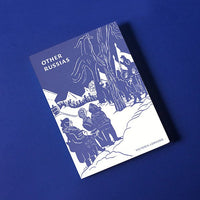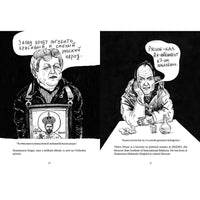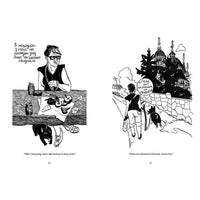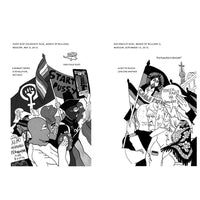- Description
Other Russias is an album of images and impressions of ordinary, unconnected Russian citizens who have unexpectedly found themselves activists.
Victoria Lomasko, a graduate of Moscow State University of Printing Arts, found herself becoming an activist simply by doing her art out in the world. Yet her “first work of graphic reportage was rejected out of hand. I was told that no one drew from life in the 21st century. But I felt the need to complete my drawings on the spot, to serve as a conductor for the energy generated by events as they happened.” (8) Or, as I would put it, she was the magician that captured the energy as she sketched the voiceless and disregarded (the “Invisible” of Part 1 of her book) or the cynically persecuted (the “Angry” of Part 2): for example, the members of Pussy Riot; the countless non-Slavic Russian citizens discriminated against for jobs and housing; principled legal staff; and the LGBTQ, who have to fear for their safety and family-life in the face of religious bigotry.
In the introduction, Lomasko explains her choice of drawing over cameras: “I turned to the practices of the 19th and 20th centuries – namely to the albums produced by Russian soldiers, concentration camp inmates, and people who experienced the Nazi siege of Leningrad. In many cases, urgent work like this was the only kind of reporting that was done in these brutal conditions – these albums were the sole acts of witness.” (8) The key word is “urgent.” Art is always dangerous to authoritarian governments, because the artist’s individual opinions and beliefs permeate the images.
We love photographic images because they seem so real, and yet one of their drawbacks is that they hypnotize us into forgetting who’s behind the camera and who’s paying for the technology. These drawings, on the other hand (and a live hand at that), are active and responsive art; they can’t help communicating Lomasko’s sympathy, interest and bewilderment. We never forget that she, a living, engaged witness, is recording her impressions; her most inspired drawings are representations of a change in time: they reveal earnest people with pasts who have suddenly found themselves in their surprising new roles as protesters.
At first, Lomasko says, she was shy of the “ordinary” people she was surreptitiously drawing, until she finally “worked up the courage to engage them in conversation and ask questions. Later, I began to approach my subjects as a journalist would, traveling to various places to research topics that fascinated me.” (9)
What all the subjects have in common is that they are believers. From all walks of Russian life, they believe in a moral cause – some in the morality of individual conscience, some in the morality of church and state control.
For instance, the protesters on Pushkin Square I myself remember from visits to Moscow are admirably sturdy and obviously brave: “Every Saturday, rain, snow, or frost, a group of Orthodox activists holds a prayer service and protest rally against Moscow Mayor Yuri Luzhkov’s urban planning policies.” (29) Yet Lomasko’s reportage reveals that they’re also, unfortunately, purveyors of a shameless anti-Semitism: “Pray against kikes?” says one. “It won’t help.” (31)
Author: Victoria Lomasko
Translator: Thomas Campbell
Publisher: N+1
Pages: 320pp
Size: 5.25 x 7.25 x 1
Notes: perfect bound, b/w
Release Date: March 2017
ISBN: 978-0997031843








